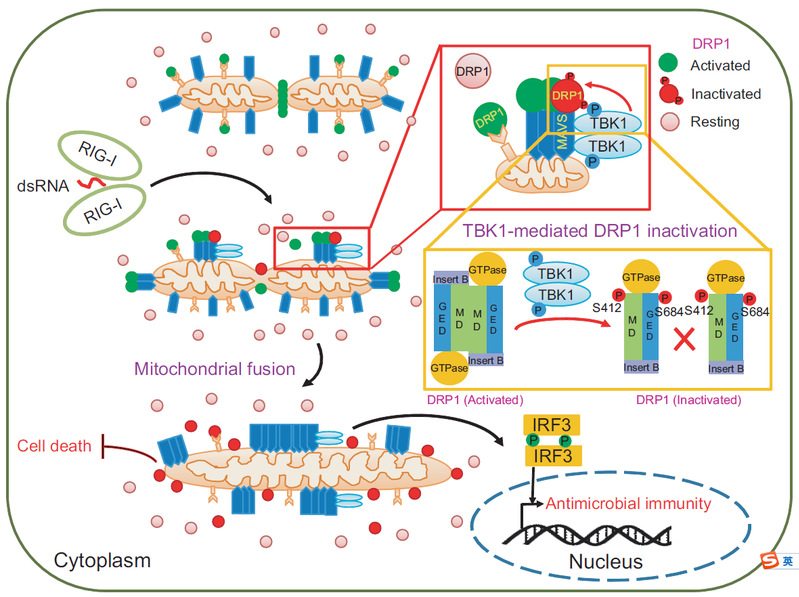On November 9th 2020, Pinglong Xu laboratory published the research article entitled “TBK1-mediated DRP1 targeting confers nucleic acid sensing to reprogram mitochondrial dynamics and physiology” in Molecular Cell, which describes an interesting cellular function of innate nucleic acid sensing in control of both dynamics and physiology of mitochondrion.
Mitochondrial morphology shifts rapidly to manage cellular metabolism, organelle integrity, and cell fate. It remains unknown whether innate nucleic acid sensing, the central and general mechanisms to monitor both microbial invasion and cellular damage, can reprogram and govern mitochondrial dynamics and function. Here, we unexpectedly observed that upon activation of RLR-MAVS signaling, TBK1 directly phosphorylated DRP1/DNM1L, which disabled DRP1, preventing its high-order oligomerization and mitochondrial fragmentation function. The TBK1-DRP1 axis was essential for assembly of large MAVS aggregates and healthy antiviral immunity, and underlay nutrient-triggered mitochondrial dynamics and cell fate determination. Knockin strategies mimicking TBK1-DRP1 signaling produced dominant-negative phenotypes in reminiscent of human DRP1 inborn mutations, while interrupting the TBK1-DRP1 connection compromised antiviral responses. Thus, our findings establish an unrecognized function of innate immunity governing both morphology and physiology of a major organelle, identify a lacking loop during innate RNA sensing, and report an elegant mechanism for shaping mitochondrial dynamics.

Innate RNA sensing governs mitochondrial dynamcis and function via the MAVS-TBK1-DRP1 cascade
Drs. Shasha Chen, Shengduo Liu and Junxian Wang in Xu laboratory are the first authors, and Dr. Pinglong Xu is the corresponding author for this research article. This study was collaborated by Drs. Jun Qin, Hai Song, Jian Zou, Songying Ouyang, Xin-Hua Feng, Tingbo Liang and other colleagues, sponsored by NSFC Projects (Distinguished Young Scholars and Key Project) and accomplished in Life Sciences Institute (LSI) at Zhejiang University.
Link:https://www.cell.com/molecular-cell/fulltext/S1097-2765(20)30725-5
Full text (free access):https://authors.elsevier.com/a/1c2V-3vVUPDfet



